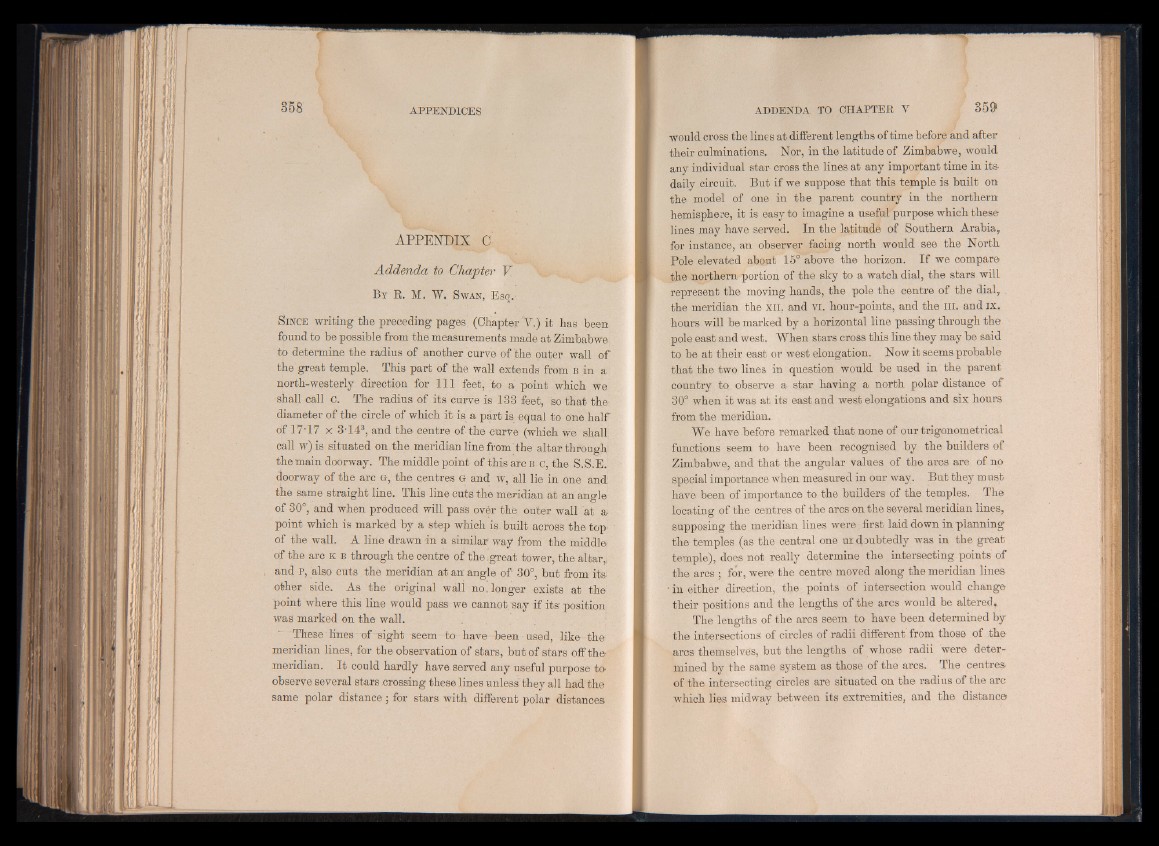
APPENDIX C
Addenda to Chapter V
By E. M. W. Swan, Esq.'
S in c e writing the preceding pages (Chapter V . ) it has been
found to he possible from the measurements made at Zimbabwe
to determine the radius of another curve of the outer wall o f
the great temple. This part of the wall extends from B in a
north-westerly direction for 111 feet, to a point which we
shall call c. The radius of its curve is 133 feet, so that the-
diameter of the circle of which it is a part is equal to one half
of 17T7 x 3-143, and the centre of the curve (which we shall:
call w )is situated on. the meridian line from the altar through
the main doorway. The middle point of this arc B c, the S.S.E.
doorway of the arc G, the centres G and w, all lie in one and
the same straight line. This line cuts the meridian at an angle
of 30°, and when produced will pass ovbr the outer wall at a*
point which is marked by a step which is built across the top
of the wall. A line drawn in a similar' way from the middle;
of the arc K B through the centre of the .great tower, the altar,;
and P, also cuts the meridian at an angle o f 30°, but from its
other side. As the original wall no. longer exists at the
point where this line would pass we cannot say if its position
was marked on the wall.
These lines of-sight -seem to have been used, like-the-
meridian lines, for the observation of stars, but of stars off the
meridian. It could hardly have served any useful purpose to-
observe several stars crossing these lines unless they all had the
same polar distance; for stars with different polar distances
would cross the lines at different lengths of time before and after
their culminations. Nor, in the latitude of Zimbabwe, would
any individual star cross the lines at any important time in its
daily circuit. But if we suppose that this temple is built on
the model of one in the parent country in the northern
hemisphere, it is easy to imagine a useful purpose which these
lines may have served. In the latitude of Southern Arabia,
for instance, an observer facing north would see the North
Pole elevated about 15° above the horizon. I f we compare
the northern portion of the sky to a watch dial, the stars will
represent the moving hands, the pole the centre of the dial,
the meridian the x i i , and VI, hour-points, and the i n . and ix .
hours will be marked by a horizontal line passing through the
pole east and west. When stars cross this line they may be said
to be at their east or west elongation. Now it seems probable
that the two lines in question would be used in the parent
country to observe a star having a north polar distance of
30° when it was at its east and west elongations and six hours
from the meridian.
We have before remarked that none of our trigonometrical
functions seem to have been recognised by the builders of
Zimbabwe, and that the angular values of the arcs are of no
special importance when measured in our way. But they m ust
have been of importance to the builders of the temples. The
locating of the centres of the arcs on the several meridian lines,
supposing the meridian lines were first laid down in planning
the temples (as the central one urdoubtedly was in the great
temple), does not really determine the intersecting points of
the arcs ; for, were the centre moved along the meridian lines
- in either direction, the points of intersection would change
their positions and the lengths of the arcs would be altered*
The lengths of the arcs seem to have been determined by
the intersections of circles of radii different from those of the
arcs themselves, but the lengths of whose radii were determined
by the same system as those of the arcs. The centres
of the intersecting circles are situated on the radius of the arc
which lies midway between its extremities, and the distance